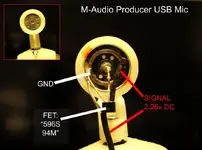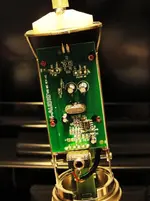jaykeMURD
I sit on you.
I decided to open up my M-Audio Producer USB and see what's going on behind the grill.
The mic is sometimes advertised as a Large-Diaphragm Condenser......I don't think this qualifies as such.
I've provided some basic info on the picture.
I'm curious as to what that FET is doing?
I can't find any info on that particular FET...
I wonder if an actual large diaphragm capsule could be fitted to the mic? What are the power requirements of your run-of-the-mill chinese LD capsule?
The mic is sometimes advertised as a Large-Diaphragm Condenser......I don't think this qualifies as such.
I've provided some basic info on the picture.
I'm curious as to what that FET is doing?
I can't find any info on that particular FET...
I wonder if an actual large diaphragm capsule could be fitted to the mic? What are the power requirements of your run-of-the-mill chinese LD capsule?




 ), including a source resistor, and measure noise & level again. Those three components (FET & two resistors) can all be done point-to-point at the capsule, as with stock.
), including a source resistor, and measure noise & level again. Those three components (FET & two resistors) can all be done point-to-point at the capsule, as with stock.